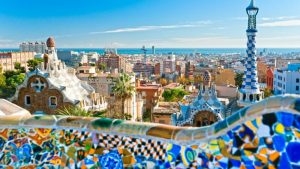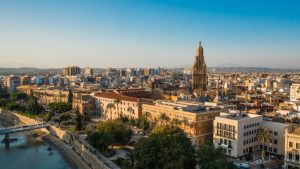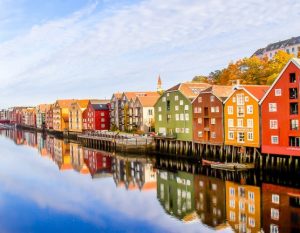 Spain : Safety by City
Spain : Safety by City
- Alicante
- Andorra la Vella
- Barcelona
- Bilbao
- Cadiz
- Canary Islands
- Granada
- Ibiza
- Las Palmas
- Madrid
- Malaga
- Murcia
- Palma de Mallorca
- Pamplona
- Salamanca
- San Sebastian
- Seville
- Valencia
- Zaragoza
In the Navarre section of Northern Spain, Pamplona is nestled on the flood plain of the Arga River.
As a result of its water-based location, the city’s history dates back to the late Bronze and early Iron Ages.
The city is most famous for its Running of the Bulls event held annually from July 6th through the 14th during the San Fermin Festival.
In addition to the festival, the city boasts several beautiful churches and other civil architectural marvels.
This small city is one of the safest in Spain, even at night for solo female travelers.
The locals are friendly, and the crime rates are considerably lower than in other larger Spanish cities.
Most of the crimes that occur are petty, such as pickpocketing during festival seasons.
Despite its reputation of being a safe destination, it’s always important to be vigilant in crowded areas and keep a close eye on your belongings.
If you’re considering traveling to Pamplona, keep reading to learn more about the dangers, safest places to visit and avoid, safety tips, and other helpful information!
Warnings & Dangers in Pamplona

OVERALL RISK: LOW
As one of the safest cities in the country, the overall safety risk of visiting Pamplona is low. The most significant crime a small number of victims will experience is pickpocketing. It's incredibly rare to encounter violent crimes, as most are petty. Car break-ins are a significant consideration when renting a vehicle, so removing all items from the car when parking is important. Other crimes are property-related, and violent crime is nonexistent.

TRANSPORT & TAXIS RISK: MEDIUM
Public transportation and taxis are dependable and safe in Pamplona, with ridesharing apps becoming the norm. Always be aware of your route when taking taxis since some dishonest drivers will attempt to overcharge or take you the long way. Public transit is safe, but it is where many pickpockets operate, so be aware of your surroundings.

PICKPOCKETS RISK: MEDIUM
Spain gets tens of millions of tourists yearly, and the Running of the Bulls is the most popular and well-known event in Pamplona. With so many tourists visiting, this is the best time for pickpockets and scammers to operate. Outside this event, tourism is significantly lower, but you must still be vigilant in crowded places and never carry valuables.

NATURAL DISASTERS RISK: LOW
Given Pamplona's elevation of over 1,400 feet, the only natural disaster that occurs is mudslides after rain. Otherwise, they aren't subjected to any major disaster risks.

MUGGING RISK: LOW
While pickpocketing is a problem, violent crime, and kidnapping are incredibly rare in Pamplona. It's still important to never accept unsolicited drinks or assistance from strangers. Drink spiking is not an issue in Pamplona, but keeping your guard up is essential when traveling.

TERRORISM RISK: MEDIUM
The most recent terrorist attack was in mid-August 2017, when two terrorist incidents involved driving vehicles into pedestrians, resulting in death and injury. While these unfortunate events didn't occur in Pamplona, a terrorist attack could happen, given the number of attendees of the Running of the Bulls. If you see someone acting suspiciously, immediately contact the local authorities.

SCAMS RISK: LOW
One of the most common scams in Pamplona is a gypsy woman offering rosemary, reading your future, requesting money, or having a second person pick your pockets while you're distracted. Also, be aware of the shell game, where you are set up to lose. Always double-check the bill in bars and restaurants since the staff could overcharge.

WOMEN TRAVELERS RISK: LOW
Female travelers will likely be fine in Pamplona as the locals are friendly and welcoming. It's important to use common sense in certain situations still, avoid poorly lit or abandoned areas, and be extra cautious at night.

TAP WATER RISK: LOW
The tap water around Spain, especially in the cities, is very safe for consumption. The city maintains high water quality control standards and notes that tap water has better mineral content than bottled water. This means you can consume tap water without worrying about illness, disease, or other safety concerns. This also helps you save money by bringing a water bottle and filling it up at various taps.
Safest Places to Visit in Pamplona
Given that the entire city is safe, you can go anywhere on foot, by bicycle, taxi, or bus, day or night.
However, the best places to visit and stay include Casco Viejo (Old Town), which features the Plaza del Castillo, Museum of Navarra, and Pamplona Cathedral; Ensanche 1 and 2, which are buzzing neighborhoods and San Juan, a more residential alternative.
San Juan is home to Parque Yamaguchi, designed by Japanese landscape architects, and is an exceptional place to spend time walking and relaxing.
Places to Avoid in Pamplona
Pamplona is a safe city day and night so that no area can be avoided.
Instead, it’s important to stay away from secluded and abandoned buildings or neighborhoods and don’t walk down poorly lit streets or dark alleys.
While any crime is unlikely, even in these areas, it’s important not to put yourself in a situation that could prompt a robbery, kidnapping, or theft despite the tiny risk.
Also, it’s important to take extra caution during the San Fermin Festival, when tens of thousands of tourists flock to the city.
Safety Tips for Traveling to Pamplona
- Be Careful at ATMs. While ATMs are plentiful and safe in Pamplona, be aware of your surroundings when withdrawing money. You want to hide your PIN in case someone is watching and refrain from withdrawing cash late at night or in the early morning hours when the streets are secluded. If you must, be incredibly vigilant as to your environment.
- Be Vigilant in Crowded Areas. The most crowded locations in Pamplona are magnets for pickpockets. These include tourist attractions such as museums or landmarks, on crowded public transportation, in hotel lobbies, or at bars and restaurants. In all these locations, visitors are distracted for one reason or another, making them easy targets to lift a phone or wallet.
- Bring Only What You Need for the Day. The old saying, “Don’t put all your eggs in one basket,” is also true for traveling. Always carry as minimal cash as possible, separate your credit cards, leaving most at the hotel, and carry only one for the day. Also, never publicly bring your passport; it is your most important document. Additionally, try to avoid bringing a backpack, but if you do, ensure you carry it in front of your body.
- Don’t Leave Belongings in Cars. Car break-ins occur in Pamplona by opportunistic thieves. This means that they see an expensive item they want in the car, and they smash the window or pick up the lock. This can easily be avoided by leaving items in the trunk or entirely out of sight. Most petty criminals won’t break into an empty car unless they attempt to steal it.
- Don’t Wander into Secluded Places. While this is obvious, never wander into abandoned or secluded places, especially alone at night. These areas allow thieves to rob you or cause other problems. If you accidentally end up in a secluded area of Pamplona, calmly turn around and walk back to where you came from until you run into a crowded area or busy street.
- Go Unnoticed. Tourists tend to carry more valuables and cash than locals, so thieves target them. Also, visitors tend to pay less attention to their surroundings because they’re focused on snapping photos or exploring the area. Therefore, you are less likely to be targeted by making yourself not look like a tourist. To do so, avoid constantly looking at maps and look like you know where you’re going. Before leaving the accommodation, determine how to reach your destination and walk like you know where you’re headed.
- Keep Your Wallet in the Front Pocket. This tip is especially important for crowded places like mass transit, festivals, and attractions. Keep your belongings in the front pocket since it’s much more difficult to lift than in the back. This is the best place for your phone or wallet if you have pants or a jacket with zippered pockets. Keeping items in your back pocket makes it easy for pickpockets to “accidentally” bump into you and lift your wallet simultaneously.
- Make Copies of Important Documents. As a failsafe, make copies or take photos of your important documents before departing the trip. This includes your driver’s license, passport, and the front and back of your credit cards. If you lose an item or it is stolen, especially your passport, this will expedite a new passport from your country’s embassy. While this will not keep you safe from thieves, having physical and digital copies is always great.
- Use Common Sense. When exploring Pamplona, use common sense and trust your gut. If something doesn’t feel right, you should leave the area. For instance, if you’re speaking with a local and asking many questions, they could be distracting you from someone else lifting your wallet or belongings. Politely stop the conversation and walk away before you become the next victim.
- Use the Hotel Safe. It’s always advisable to leave expensive items in your accommodation. However, leaving money, a credit card, your passport, or other important belongings on the table is susceptible to theft if you’ve requested turndown service. Therefore, when storing important documents and expensive items in your room, use the hotel safe or lock them in your luggage.
So... How Safe Is Pamplona Really?
Pamplona is considered one of the safest cities in Spain for a reason: crime is not an issue.
Like in many smaller Spanish cities, the most significant crimes are petty theft, such as scams, pickpocketing, and other swindling.
Otherwise, if you plan to visit Pamplona, rest assured that you will be safe and unlikely to have a problem if you remain vigilant and use common sense.
How Does Pamplona Compare?
| City | Safety Index |
|---|---|
| Pamplona | 81 |
| Andorra la Vella | 89 |
| Madrid | 68 |
| Barcelona | 67 |
| Valencia | 69 |
| Seville | 71 |
| Bilbao | 52 |
| Rio de Janeiro (Brazil) | 43 |
| Sofia (Bulgaria) | 73 |
| Siem Reap (Cambodia) | 63 |
| Phnom Penh (Cambodia) | 61 |
| Niagara Falls (Canada) | 87 |
| Calgary (Canada) | 82 |
Useful Information

Visas
Visitors from most countries don't need a visa to enter Spain for less than 90 days. You must obtain a visa from the local State Department any longer. Also, ensure your passport is valid six months or longer after your return date.

Currency
Since Spain is in the European Union, it utilizes the Euro as its only currency. ATMs are readily available throughout Pamplona, but most establishments accept cash. If you're on a budget, consider approximately 150 Euros daily, including basic accommodation.

Weather
Given its location between the North Atlantic Basin and the country's arid interior, Pamplona is significantly milder than its southern sister cities, with plenty of rain. Also, its elevation in the mountains ensures that the temperature approaches freezing at an average low during the winter. However, Pamplona doesn't receive much snow; it rains significantly in the cooler months and is dry in the summer.

Airports
The closest airport is Pamplona, only an 18-minute journey from the city center. Other area airports are much further away, such as San Sebastian, which takes about three hours; Biarritz, which requires three hours and 20 minutes; and Bilbao, which is about three hours and 30 minutes away by mass transit.

Travel Insurance
Travel insurance is always recommended for travelers going to other countries. Purchasing travel insurance financially protects you from international medical expenses, lost or stolen bags, passports, money, or other items, airline delays, and other issues that could arise during travel.
Pamplona Weather Averages (Temperatures)
Average High/Low Temperature
| Temperature / Month | Jan | Feb | Mar | Apr | May | Jun | Jul | Aug | Sep | Oct | Nov | Dec |
|---|---|---|---|---|---|---|---|---|---|---|---|---|
| High °C | 9 | 11 | 14 | 16 | 20 | 24 | 27 | 27 | 24 | 19 | 13 | 9 |
| Low °C | 2 | 3 | 4 | 6 | 9 | 13 | 15 | 15 | 13 | 9 | 5 | 3 |
| High °F | 48 | 52 | 57 | 61 | 68 | 75 | 81 | 81 | 75 | 66 | 55 | 48 |
| Low °F | 36 | 37 | 39 | 43 | 48 | 55 | 59 | 59 | 55 | 48 | 41 | 37 |
Spain - Safety by City
| City | Safety Index |
|---|---|
| Alicante | 77 |
| Andorra la Vella | 89 |
| Barcelona | 67 |
| Bilbao | 52 |
| Cadiz | 74 |
| Canary Islands | 81 |
| Granada | 58 |
| Ibiza | 82 |
| Las Palmas | 74 |
| Madrid | 68 |
| Malaga | 76 |
| Murcia | 83 |
| Palma de Mallorca | 57 |
| Pamplona | 81 |
| Salamanca | 59 |
| San Sebastian | 56 |
| Seville | 71 |
| Valencia | 69 |
| Zaragoza | 79 |











